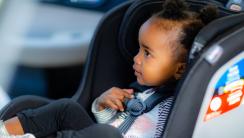Roberts Center for Pediatric Research 2716 South Street, 13th Floor Philadelphia, PA 19146
Breadcrumb
RESEARCH PORTFOLIO
Principal Investigator: Rachel Myers, PhD
The goal of this study is to create a unique source of epidemiologic crash data that enables novel description of use and installation patterns of child restraints among crash-involved children and— following linkage with hospital discharge and death certificate data—novel description of child occupant injury outcomes based on restraint use and installation (rear- vs. forward-facing).2023-2024
- Posture and Belt Fit of Children in Reclined Vehicle Seats
Principal Investigator: Gretchen Baker, PhD
With increased possibilities of advanced and autonomous driver assistance systems, future vehicle occupants may begin to engage in a wider range of activities and assume a larger range of postures, including reclined vehicle seatback orientations. However, no study has yet evaluated the influence of reclined vehicle scenarios on the static posture and belt fit for children.
- Adjacently Restrained Pediatric Occupants and CRS Interaction in Oblique Impacts
Principal Investigator: Madeline Griffith, MS
The aim of this study is to use sled testing to examine the effect of child restraint system overlap and interaction on adjacently seated rearward- and forward-facing pediatric occupants in an oblique impact.
- Anthropometric Variation in Premature Babies for Optimal CRS Fitment
Principal Investigator: Jalaj Maheshwari, MS
Testing standards, which regulate design of child restraint systems (CRS), have set upper weight limits for children. However, there is no regulation on the lower weight limit. CRS manufacturers generally recommend a 5 pound lower weight limit, which creates a challenge for premature infants who often weight less than 5 pounds. The specific aim of this study is to collect and analyze anthropometric dimensions across a range of low birth weight and…
- Interactions Between Aircraft Airbags and Child Occupants
Principal Investigator: Julie Mansfield, PhD
A variety of new air bags are being introduced into commercial aircraft cabins, with no currently available data to determine if any of the air bags offer protection to children, whether they might injure children, or whether they can be used in conjunction with child restraint systems (CRS) on aircraft. This study aims to provide these data through static installations and dynamic crash testing.
- Pediatric Shoulder Anthropometry and Improvement of Belt Fit Evaluation Tools
Principal Investigator: Julie Mansfield, PhD
The external contours of the shoulders of anthropomorphic test devices (ATDs) are over-simplified and lack important anatomical details that are important to determine optimal shoulder belt placement. This study aims to develop an improved shoulder form to better represent children’s shoulders during belt fit evaluations using
current ATDs.- Interactions Between Rearward-Facing Child Restraint Systems with a Support Leg and the Center Console in Frontal Impact Sled Tests
Principal Investigator: Declan Patton, PhD
Installing a child restraint system (CRS) in the rear center seating position of a vehicle is common, especially rearward-facing CRS, as it is anecdotally considered the safest position. Only one study has investigated the interactions between rearward-facing CRS models and the center console during frontal impacts, which found that CRS contact with a center console resulted in elevated peak resultant head accelerations.
- Identifying Key Eye-Tracking Metrics Associated with Cognitive Control While Driving, Validated by MEG Neuroimaging: Phase III
Principal Investigator: Thomas Seacrist, MBE
Recent developments in eye-tracking and neuroimaging techniques are paving the way for novel approaches to understanding cognitive workload and cognitive errors during driving. Building on prior “MEG + Driving + Eye-Tracking” work, this study aims to (1) identify eye-tracking metrics that proxy increased cognitive control in a new cognitively challenging unanticipated steering task and (2) compare these eye-tracking metrics and frontal lobe…
- Identifying Key Eye-Tracking Metrics Associated with Cognitive Control While Driving, Validated by MEG Neuroimaging: Phase III
Principal Investigator: Elizabeth Walshe, PhD
Recent developments in eye-tracking and neuroimaging techniques are paving the way for novel approaches to understanding cognitive workload and cognitive errors during driving. Building on prior “MEG + Driving + Eye-Tracking” work, this study aims to (1) identify eye-tracking metrics that proxy increased cognitive control in a new cognitively challenging unanticipated steering task and (2) compare these eye-tracking metrics and frontal lobe…
- Identifying the Relationship Between Scanning and Executive Functions Among Young Drivers
Principal Investigator: Thomas Seacrist, MBE
One aspect of driving that is both critical for crash avoidance and influenced by executive function is scanning, or the pattern of eye glances used to detect hazards. Previous research has shown that drivers with poor executive function are less likely to detect road hazards; however, these studies do not identify the underlying scanning patterns contributing to this poor hazard detection.

